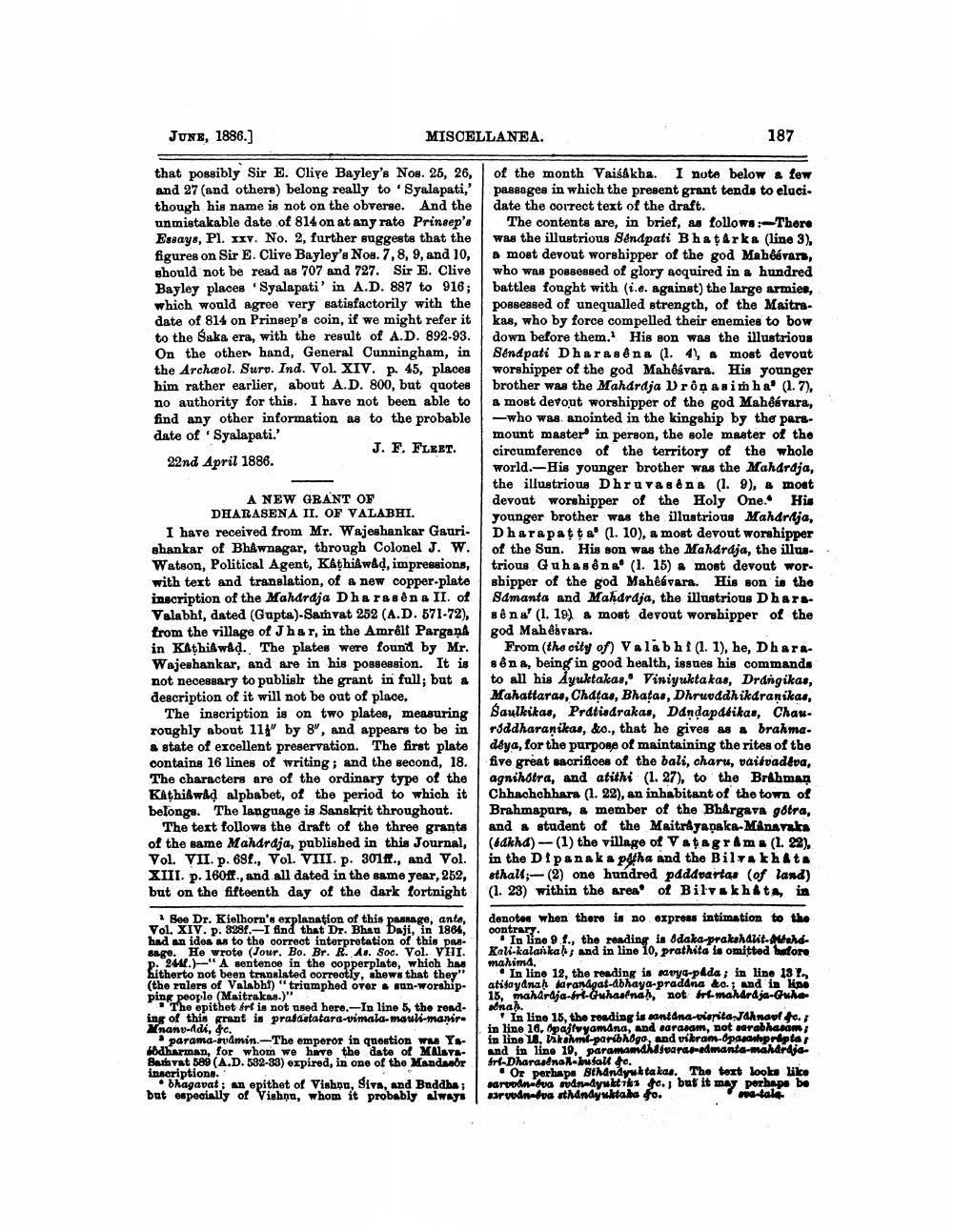________________
JUNE, 1886.]
MISCELLANEA.
187
that possibly Sir E. Clive Bayley's Nos. 25, 26, and 27 (and others) belong really to 'Syalapati,' though his name is not on the obverse. And the unmistakable date of 814 on at any rate Prinsep's Essays, Pl. Ixv. No. 2, further suggests that the figures on Sir E. Clive Bayley's Nos. 7, 8, 9, and 10, should not be read as 707 and 727. Sir E. Clive Bayley places Syalapati' in A.D. 887 to 916; which would agree very satisfactorily with the date of 814 on Prinsep's coin, if we might refer it to the Saka era, with the result of A.D. 892-93. On the other hand, General Cunningham, in the Archæol. Suro. Ind. Vol. XIV. p. 45, places him rather earlier, about A.D. 800, but quotes no authority for this. I have not been able to find any other information as to the probable date of 'Syalapati.'
J. F. FLEET. 22nd April 1886.
A NEW GRÁNT OF DHARASENA II. OF VALABHI. I have received from Mr. Wajeshankar Gauri. shankar of BhÅwnagar, through Colonel J. W. Watson, Political Agent, Kathiwad, impressions, with text and translation, of a new copper-plate ingcription of the Mahardja Dharasena II. of Valabhi, dated (Gupta)-Samvat 252 (A.D. 571-72), from the village of Jhar, in the Amrelt Pargana in Kathiawad. The plates were found by Mr. Wajeshankar, and are in his possession. It is not necessary to publish the grant in full; but a description of it will not be out of place.
The inscription is on two plates, measuring roughly about 111' by 8", and appears to be in a state of excellent preservation. The first plate contains 16 lines of writing; and the second, 18. The characters are of the ordinary type of the Kathiawad alphabet, of the period to which it belongs. The language is Sanskrit throughout.
The text follows the draft of the three grants of the same Mahardja, published in this Journal, Vol. VII. p. 68f., Vol. VIII. p. 3018., and Vol. XIII. p. 160ff., and all dated in the same year, 252, but on the fifteenth day of the dark fortnight
of the month Vaisakha. I note below a few passages in which the present grant tends to eluci. date the correct text of the draft.
The contents are, in brief, as follows:- There was the illustrious Sendpati Bhatarka (line 3), a most devout worshipper of the god Mahéévan, who was possessed of glory acquired in a hundred battles fought with (i.e. against) the large armies, possessed of unequalled strength, of the Maitrakas, who by force compelled their enemies to bow down before them. His son was the illustrious Sendpati Dharasena (1.4), « most devout worshipper of the god Mahêśvara. His younger brother was the Mahardja Drôn asinha' (1.7), a most devout worshipper of the god Mahesvara,
-who was anointed in the kingship by the partmount master in person, the sole master of the circumference of the territory of the whole world.-His younger brother was the Mahardja, the illustrious Dhruvasena (1.9), a most devout worshipper of the Holy One. His younger brother was the illustrious Mahdrilja, Dharapatta (1. 10), a most devout worshipper of the Sun. His son was the Mahardja, the illustrious Guhasena (1. 15) . most devout wor. shipper of the god Mahesvara. His son is the Samanta and Mahardja, the illustrious Dharssê na' (1. 19) a most devout worshipper of the god Mahêsvara.
From the city of) Valabh (1.1), he, Dhara. sên a, being in good health, issues his commands to all his Ayuktakas, Viniyuktakas, Drangikas, Mahattaras, Chagas, Bhagas, Dhruvddh ikdranikas, Saulkikas, Prdtisdrakas, Dandapatikas, Chauriddharanikas, &o., that he gives as a brahma. déya, for the purpose of maintaining the rites of the five great sacrifices of the bali, charu, vaidvad agnihotra, and atithi (1. 27), to the Brahman Chhachchhara (1. 22), an inhabitant of the town of Brahmapura, & member of the Bhargava gótra, and a student of the Maitrayapaka-Manaraka (lakha)-(1) the village of Vatagram (1. 22), in the Dipanak a patha and the Bilrakhata sthall; (2) one hundred paddvartas (of land) (1. 23) within the area of Bilvakhet, in
* See Dr. Kielhorn's explanation of this passage, ante, Vol. XIV. p. 328.-I find that Dr. Bhau Daji, in 1864, had an idea as to the correct interpretation of this page sage. He wrote (Jour. Bo. Br. R.As. Soc. Vol. VHI. p. 244. "A sentence in the copperplate, which has hitherto not been translated correctly, shews that they" (the rulers of Valabht) "triumphed over . sun-worshipping people (Maitrakas)"
The epithet ért is not used here.--In line 5, the read. ing of this grant is pragastatara-vimala-mauli-manirXnano-Adi, &c.
parama-ramin.-The emperor in question Wa Y.bodharman, for whom we have the date of Malays. Batavat 589 (A.D. 582-83) expired, in one of the Mandeer inscriptions.
• bhagavat; an epithet of Vishnu, Siva, and Buddha; but especially of Vishnu, whom it probably always
denotes when there is no express intimation to the contrary.
In line 91., the reading in ddaka-prakshatit. MbandKali-kalankab; and in line 10, prathita is omitted hatore mahima.
In line 12, the reading is savyg-peda; in line 131 atijayanah baranágat-abhaya-pradana do.; and in kino 15, mahardja-frl-Guhaanah, not fri-mahardja-Gula nan.
In line 15, the reading is santana-vispita Jaknault. in line 16. paftvyamana, and sarasam, not sarabha.com in line 16, Akshmi-paribhogo, and vikram-pasartpripta and in line 19, paramamahagvarapadmanta-mahardja fri Dharaanalaisal to.
Or perhaps thanayuktakas. The text looks like sarvodnedva sydnedykt go, but it may perhape bo wrudn-fra sthandyuktaila go.
ma-taka




